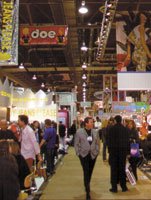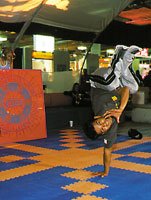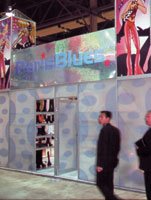MAGIC: Taking Care of Business
MAGIC International, the apparel industry’s semi-annual pilgrimage to the desert, got off to its traditional quiet start for its Feb. 13–16 run in Las Vegas, but exhibitors and buyers said they were anticipating brisk—if not stellar—sales overall.
Day one of the massive trade show is always more about schmoozing and perusing and trend-spotting than it is about writing business anyway; and this year the slowing economy was on many people’s minds.
The show, which is spread across three venues—the Las Vegas Convention Center, the Sands Expo & Convention Center and the Las Vegas Hilton—and covers nearly every apparel category, including men’s and women’s apparel, streetwear, surf and skate apparel, junior, clubwear and childrenswear. Plus, some buyers took time out to visit the Rio Hotel, where the Women’s Wear in Nevada (WWIN) show was underway for its parallel four-day run.
MAGIC organizers predicted more than 100,000 attendees and more than 3,000 exhibiting companies, although at press time, final attendee numbers for the show were not available. But, nonetheless, exhibitors were expecting the pace of business overall to be brisk at the very least.
“There’s nothing to complain about, but it’s not like a year ago,” said Laura Hong, owner of Los Angeles-based junior jeanswear manufacturer Bubblegum USA. “I think last February’s [MAGIC] was a fluke because the economy was out of control and it was just doing so well.”
A question mark hangs over the economy this February, however, and apparel buyers big and small from all around the country are obliged to consider the possibility of a downturn.
“The price has to be right,” said Pat Bell, owner of Pat’s Exclusives, a boutique catering to career and church-going women in Fort Washington, Md. She’s been in business 14 years and said she would spend $40,000 at this, her third MAGIC. But this show she’s cutting back on some slow-selling sizes she’d bought in previous years, because, as she put it, “I don’t know how the economy’s doing.”
Not every buyer in the apparel business—being as vast as it is—is looking at the same downturning economy. Delia’s, for example, began the new year doing strong business, according to retail buyer Suzanne East, one of the 13 representatives of the New York-based 31-store chain sent out to Las Vegas. The buyers from Delia’s will be leaving more paper than they did at previous show’s, according to several of the buyers. They’re also looking for a “lot of direction going into early back-to-school,” East added, and on MAGIC’s first day they had already done business with two brand-new companies—one selling shirts, the other selling sweaters. Their other mission at this MAGIC: Get on the trends faster.
“We’re in the junior business,” said Holly Brennan, retail accessories buyer for Delia’s. “We’ve got to get on it fast.”
Many buyers said they are being more cautious and prudent with their open-to-buy dollars, but buyers are always careful in their purchasing decisions, said Michele Dahan, co-owner of Vernon, Calif.-based young men’s and junior line Tag Rag.
“There’s no excuse,” she said. “Manufacturers just have to work harder and put out better product.”
Some manufacturers tend to use the downbeat economic forecast as an excuse for a less than stellar season, Dahan added. One reason the MAGIC aisles seemed somewhat less crowded than previous opening days, she said, was that a “lot of people are consolidating. So that rather than seeing a lot of little stores, we’re seeing a lot of big stores that are placing big orders.”
Nikki Young, sales rep for Los Angeles-based Roxywear agreed.
“Anybody that complains of a bad show, just doesn’t have the right product,” she said.Making a Big Booth Statement
Economy aside, JNCO was one of many streetwear and denim companies that did strong business from the moment MAGIC opened its doors.
“It’s been great,” said Henry Abeger, an executive with the Los Angeles-based young men’s label. “We’ve been packed with buyers from Japan, Mexico, Colombia and Canada.”
Most likely one of those buyers was Cristina Agaton, chief buyer for the 26-store, Caracas, Venezuela-based Gina chain, who doesn’t speak English but understands the international language of apparel very well. She said she would spend up to $750,000 buying separates and dresses for spring and summer.
Moshe Tsabag, owner of Los Angeles-based Hot Kiss, like many junior manufacturers at the show, also boasted that his booth had “been jammed from the moment we opened. And it’s going to be like this for the next few days.”
Tsabag said his strategy for keeping the “slowing economy” from affecting his business was to advertise heavily.
“[Buyers] want to be with lines that have a good marketing strategy and are well-advertised.”
Other busy booths that fit the Tsabag formula of large-scale marketing included XOXO, Rampage, OP, Tommy Bahama and JNCO Jeans.
One newcomer that had big crowds and hot buzz was Argentina- and Venezuela-based Kosiuko, which brought in tanned and willowy South American models and beauty queens, including one runner-up to Miss Universe and the current Miss Venezuela, to model its bosom-skimming tops and super low-cut jeans. The bevy of beauties caused one fuming competitor to complain: “That goes to show that sex sells. People are placing orders just to be near those South American bombshells.”
Kosiuko, which is well known in South America, has two relatively new stores in Miami. The company is planning a nationwide assault on the lucrative American jeans market, and its first-time presence at MAGIC clearly demonstrates the trade show’s value as a high-visibility launching pad. The company spent in excess of $50,000 for its booth and to bring in the models and its staff, according to Kosiuko president, Carlos Sultan.
“It’s worth it,” Sultan said confidently. “We’ve got all the tickets to the raffle. We’re just waiting for the raffle to be held.”
Other elaborate booths cost their companies in the six figures.
“If this was a house, it would be in Pacific Palisades—we’re talking Brentwood, baby!” enthused Janet Orsi, a Los Angeles-based publicist representing Seattle- and New York-based men’s and women’s sportswear brand Tommy Bahama, which showed its latest lines in a two-story island plantation-house booth decorated with fine antiques and specially-created wallpaper.
The edge, the show’s venue for alternative and clubwear companies located on the first floor of the Sands, was one part of the trade show where the booths were less elaborate, but the music and the clothes were hot.
Michael Paradise, president of new edge exhibitor and budding DJ/hip-hop/streetwear line, 939, said “business was definitely happening” at his booth. The San Francisco-based executive said he landed five big accounts the first day.
“That’s really great for us, and would be for any new company,” he said.
The young, tattooed and pierced entrepreneurs at the alternate-apparel show bopped down the busy aisles to a nearly constant trance and hip-hop beat. The music-filled, party atmosphere of the edge echoed the high-energy of the streetwear section of the Las Vegas Convention Center.
But, as always, one person’s music was another person’s noise.
Tom Patella, manager for San Francisco-based denim manufacturer Sutter’s was one of a few exhibitors who made the move from the Las Vegas Convention Center to the Sands in search of an environment that was “more conducive to business.”
“Over there you have all that loud music, all that rap,” he said. “Exhibiting here is, without a doubt, a much better fit for us.”
But Irvine, Calif.-based OP’s executive vice president of sales Steve Pinkow said his company’s enclosed booth space “created a very comfortable ambience” for his customers.
Spider Kim, New York sales rep for Gardena, Calif.-based Space Girlz said she noticed buyers had a “different attitude” at this show in comparison to the August show.
“People are more serious at this show than at the August show,” she said.
“In August people come more for the weather and with a more lax attitude because I think they’ve tied that show into their vacation time.” Too Early for Fall?
This MAGIC billed itself as a show that “breaks Fall,” so most manufacturers were showing back-to-school and Fall merchandise, something that Victor Bagdasaryn, sales rep for Montreal-based leather manufacturer Oscar Leopold said may have been to blame for what he saw as “definitely slower traffic.”
“A lot of people are not buying as early for Fall as they used to,” he said. “They seem to be still looking for summer items at this point.”
That description fit buyers Sidney and Bob Bowden of Paris, Texas, who have been operating Bowden’s boutique, specializing in young contemporary apparel for 25 years. They are “buying close in,” as Bob Bowden put it, adding that they intend to spend up to $50,000, and looking for a “fabric other than linen that’s going to be interesting for summer.”
Yoland Pastore, sales rep for Montreal-based Christina Swimwear said that the show was good, “in spite of the fact that this is not a big swim show.”
“It’s been a good show for us just to meet with our regular customers and do a few re-orders.”
Dick Cantrell, owner of Los Angeles-based jeans manufacturer Hard Tail, called himself a “trade show junkie” and said that MAGIC was his company’s 12th trade show in 12 months.
“We write a lot of orders and MAGIC is one of the strongest from this standpoint,” he said.
Michael Stafford, senior vice president for Los Angeles-based Linea Pelle, Inc., Paris Blues’ parent company, also said this “show was a great way to catch up with retailers, especially with the management of the bigger department stores.”Room for Growth
This run of the show was “much improved” according to at least one exhibitor. Elan Silver, co-owner of Los Angeles-based contemporary manufacturer Dina Bar-el said the young contemporary section of WWDMAGICwas “a lot better organized this time.”
Even WWDMAGIC’s fashion director, Denise Scher, agreed that there’s always room for improvement.
“I’d love to see categories expand,” she said. “I’d like to see contemporary expand and growhellip;and accessories expand, and overall they do grow from show to show.”
MAGIC’s continuing appeal is that it provides “one-stop shopping under one roof,” Scher added.
Retailer Ron Hilton agreed. He owns Opus, a unisex shop in St. Catharine’s, Canada, and has been coming to MAGIC since it was held in California and still went by its acronym Men’s Apparel Guild in California.
“If you’re looking at the big picture, you can do this show without having to do a lot of other shows,” he said.
And that’s one reason the big show may be getting even bigger. In fact, Scher predicted that MAGIC 2002 could be 10 percent to 15 percent bigger than the present show.
As in any trade show, MAGIC will end with winners and losers. But this is Las Vegas, where the house always wins, and according to a senior analyst for the Las Vegas Convention and Visitors Authority, MAGIC’s four-day run is expected to pump approximately $237 million into Sin City’s local economy.
WWIN on the Rise
The scene was definitely more low-key at the Women’s Wear in Nevada (WWIN) show in the Rio Hotel, but many exhibitors said they were connecting with the right retailers—primarily small, specialty stores located in Western states.
The show took up two conference rooms in the hotel and show organizer Jeff Yunis said the show was already sold out for the August run, when exhibitors will take up three conference rooms. Attendance numbers were not available at press time, but Yunis said the pre-registration numbers were up from the previous year and organizers had run through their supply of 3,000 blank badges by the middle of the first day. Plus, Yunis noted that buyers with a MAGIC badge were given a WWIN sticker, rather than a separate badge, making the attendance totals for WWIN higher than just the initial badge count.
Several of the buyers shopping WWIN either had already been to MAGIC or were planning to attend the show later in the week.
Retailer Jill Tracey was shopping the show with designer Stacy Wilson, looking for sexy, plus-sized apparel for Tracey’s Miami-based boutique Jill Tracey. The two were looking for items that could be merchandised with items from Wilson’s Scion line.
“This is the best show for me,” said Tracey. “MAGIC is like being at a concert. Here, you get to see the line and they’re not rushing you.”
Many of the exhibitors were Los Angeles-based and some expressed concern that WWIN was just another show within a packed trade show calendar.
But others saw potential in WWIN’s targeted attendance, which mainly consisted of small boutique buyers.
“The show is going to be important for the West Coast,” said Arlene Henry, who was at the show with several lines from her California Mart showroom, including Silk Box, Staples and Russ Berens. This was the second WWIN show for Henry, who had previously exhibited in the contemporary section of WWDMAGIC.
Henry said she was encouraged to return after the last run of WWIN.
“The people wrote here, they are credit approved, and they came back for reorders,” she said. “I think this has the potential to be a good show.”
San Francisco-based designer Carole Doolighan said the show seemed to get off to a slow start but “if it continues at this pace, I’ll be happy.”
Doolighan, who was showing her Whispers line of novelty separates in washable crinkled silk, said she saw retailers from the Northwest, Midwest and Southwest on the first day of the show, but had bumped into familiar California retailers at the airport and expected to see them later in the run of the show.
That shared co-existence between giant MAGIC and the easily navigable WWIN is fine with the smaller show, which offers free shuttles between the Rio and the Sands.
“We’re not looking to compete with MAGIC,” Yunis said. “I feel like we’re the perfect neighbor for MAGIC.” —Alison A. Nieder
























